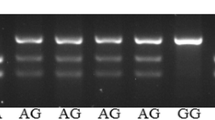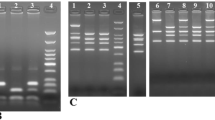Abstract
The HDL-associated paraoxonase (PON) activities play a role in decreasing oxidative stress, which is known to contribute to cancer development. The aim of this study was to examine the relation between the PON1 L55M and Q192R polymorphisms and breast cancer (BC) risk in Egyptian females and to analyze their relation to clinicopathological parameters of BC. Both polymorphisms were characterized in 100 BC Egyptian females and 100 healthy women who had no history of any malignancy by polymerase chain reaction–restriction fragment length polymorphism (PCR–RFLP) method, using DNA from peripheral blood in a case control study. With respect to PON1 L55M, the mutated allele (M) frequency was found in 70.5% in BC patients and in 53.5% in controls; the M allele was significantly associated with an increased risk of BC (adjusted odds ratio (ORadj) 2.07, 95% confidence interval (95% CI) 1.37–3.13; P = 0.011). The homozygous mutant genotype (MM) significantly increased the risk of BC (ORadj 2.07, 95% CI 1.17–3.64, P = 0.011). However, as regard PON1 Q192R, the R mutated allele frequency was found in 28.5% in BC patients and in 33% in controls, the women who were QR heterozygotes (ORadj 0.96, 95% CI 0.55–1.68) or RR homozygotes (ORadj 0.64, 95% CI 0.25–1.63), and R allele (ORadj 0.81, 95% CI 0.53–1.42) did not show any risk for BC. Both PON1 L55M and Q192R polymorphisms genotype frequencies were not related to patient’s age (P = 0.94 and 0.72, respectively). M allele genotypes (LM/MM) carriers showed significant association only with nodal metastases (P = 0.02) but not with other clinicopathologic parameters. However, R allele genotype (QR/RR) carriers showed insignificant correlation with clinicopathological parameters. In conclusion, our results suggest that the M allele of L55M polymorphism could be a suitable marker for BC susceptibility and tumor prognosis in Egyptian women.
Similar content being viewed by others
References
Smigal C, Jemal A, Ward E, Cokkinides V, Smith R, Howe HL, Thun M (2006) Trends in breast cancer by race and ethnicity: update. CA Cancer J Clin 56:168–183
Gu D, Wang M (2010) VEGF 936C > T polymorphism and breast cancer risk: evidence from 5,729 cases and 5,868 controls. Breast Cancer Res Treat. doi: 10.1007/s10549–010–0991-z
Fattahi MJ, Mojtahedi Z, Karimaghaee N, Talei AR, Ranani SJ, Ghaderi A (2009) Analysis of BRCA1 and BRCA2 mutations in southern Iranian breast cancer patient. Arch Iran Med 12:584–587
Delimaris I, Faviou E, Antonakos G, Stathopoulou E, Zachari A, Dionyssiou-Asteriou A (2007) Oxidized LDL, serum oxidizability and serum lipid levels in patients with breast or ovarian cancer. Clin Biochem 40:1129–1134
Valko M, Rhodes CJ, Moncol J, Izakovic M, Mazur M (2006) Free radicals, metals and antioxidants in oxidative stress-induced cancer. Chem Biol Interact 160:1–40
Ray G, Batra S, Shukla NK, Deo S, Raina V, Ashor S, Husain SA (2005) Lipid peroxidation, free radical, and antioxidant status in breast cancer. Breast Cancer Res Treat 59:163–170
Chander R, Kapoor NK (1990) High-density lipoprotein is a scavenger of superoxide anions. Biochem Pharmacol 40:1663–1665
Mackness B, Durrington PN, Mackness MI (1998) Human serum paraoxonase. Gen Pharmacol 31(3):329–336
Shih DM, Gu L, Xia YR, Navab M, Li WF, Hama S, Castellani LW, Furlong CE, Costa LG, Fogelman AM, Lusis AJ (1998) Mice lacking serum paraoxonase are susceptible to organophosphate toxicity and atherosclerosis. Nature 394:284–287
Humbert R, Adler DA, Disteche CM, Hassett C, Omiecinski CJ, Furlong CE (1993) The molecular basis of the human serum paraoxonase activity polymorphism. Nat Genet 3:73–76
Brophy VH, Jampsa RL, Clendenning JB, McKinstry LA, Jarvik GP, Furlong CE (2001) Effects of 5′ regulatory-region polymorphisms on paraoxonase-gene (PON1) expression. Am J Hum Genet 68:1428–1436
Aviram M, Hardak E, Vaya J, Mahmood S, Milo S, Hoffman A, Billicke S, Draganoy D, Rosenblat M (2000) Human serum paraoxonases (PON1) Q and R selectively decrease lipid peroxides in human coronary and carotid atherosclerotic lesions: PON1 esterase and peroxidase-like activities. Circulation 101:2510–2517
Stevens VL, Rodriguez C, Pavluck AL, Thun MJ, Calle EE (2006) Association of polymorphisms in the paraoxonase 1 gene with breast cancer incidence in the CPS-II Nutrition Cohort. Cancer Epidemiol Biomarkers Prev 15:1226–1228
Gallicchio L, McSorley MA, Newschaffer CJ, Huang HY, Thuita LW, Hoffman SC, Helzlsouer KJ (2007) Body mass, polymorphisms in obesity-related genes, and the risk of developing breast cancer among women with benign breast disease. Cancer Detect Prev 31:95–101
Bloom HI, Richardson WW (1957) Histological grading and prognosis. Br J Cancer 11:359–377
Breast. AJCC cancer staging manual (2002) In: American joint committee on cancer. 6th edn. Springer, New York, pp 171–180
Zama T, Murata M, Matsubara Y, Kawano K, Aoki N, Yoshino H, Watanabe G, Ishikawa K, Ikeda Y (1997) A 192Arg variant of the human paraoxonase (HUMPONA) gene polymorphism is associated with an increased risk for coronary artery disease in the Japanese. Arterioscler Thromb Vasc Biol 17:3565–3569
Feigelson HS, Henderson BE (1996) Estrogens and breast cancer. Carcinogenesis 17:2279–2284
Willett Walter C (2000) American association for cancer research diet and cancer: one view at the start of the millennium. Cancer Epidemiol Biomarkers Prev 10:3–8
Ambrosone CB (2000) Oxidants and antioxidants in breast cancer. Antioxid Redox Signal 2:903–917
Gönenç A, Erten D, Aslan S, Akinci M, Simsek B, Torun M (2006) Lipid peroxidation and antioxidant status in blood and tissue of malignant breast tumor and benign breast disease. Cell Biol Int 30:376–380
Sener DE, Gonenc A, Akinci M, Torun M (2007) Lipid peroxidation and total antioxidant status in patients with breast cancer. Cell Biochem Funct 25:377–382
Tesarová P, Kalousová M, Trnková B, Soukupová J, Argalásová S, Mestek O, Petruzelka L, Zima T (2007) Carbonyl and oxidative stress in patients with breast cancer—is there a relation to the stage of the disease? Neoplasma 54:219–224
Tesarová P, Kalousová M, Jáchymová M, Mestek O, Petruzelka L, Zima T (2007) Receptor for advanced glycation end products (RAGE)-soluble form (sRAGE) and gene polymorphisms in patients with breast cancer. Cancer Invest 25:720–725
Yu BP (1994) Cellular defenses against damage from reactive oxygen species. Physiol Rev 74:139–162
Salama SA, Kamel M, Awad M, Nasser AH, Al-Hendy A, Botting S, Arrastia C (2008) Catecholestrogens induce oxidative stress and malignant transformation in human endometrial glandular cells: protective effect of catechol-O-methyltransferase. Int J Cancer 123:1246–1254
Nebert DW, McKinnon RA, Puga A (1996) Human drug-metabolizing enzyme polymorphisms: effects on risk of toxicity and cancer. DNA Cell Biol 15:273–280
Antognelli C, Buono CD, Ludovini V, Gori S, Talesa VN, Crino L, Barberini F, Rulli A (2009) CYP17, GSTP1, PON1, and GLO1 gene polymorphisms as risk factors for breast cancer: an Italian case-control study. BMC Cancer 9:115–128
Naidu R, Har YC, Taib NAM (2010) Genetic polymorphisms of paraoxonase 1 (PON1) gene: association between L55M or Q192R with breast cancer risk and clinico-pathological parameters. Pathol Oncol Res 16:533–540
Brophy VH, Jarvik GP, Richter RJ, Rozek LS, Schellenberg GD, Furlong CE (2000) Analysis of paraoxonase (PON1) L55M status requires both genotype and phenotype. Pharmacogenetics 10:453–460
Ferrè N, Camps J, Fernandez-Ballart J, Arija V, Murphy MM, Ceruelo S, Biarnes E, Vilella E, Tous M, Joven J (2003) Regulation of serum paraoxonase activity by genetic, nutritional, and lifestyle factors in the general population. Clin Chem 49:1491–1497
Acknowledgments
This study was funded with the support of academic research in Zagazig University Projects, Zagazig University. Postgraduate & Research Affairs.
Author information
Authors and Affiliations
Corresponding author
Rights and permissions
About this article
Cite this article
Hussein, Y.M., Gharib, A.F., Etewa, R.L. et al. Association of L55M and Q192R polymorphisms in paraoxonase 1 (PON1) gene with breast cancer risk and their clinical significance. Mol Cell Biochem 351, 117–123 (2011). https://doi.org/10.1007/s11010-011-0718-4
Received:
Accepted:
Published:
Issue Date:
DOI: https://doi.org/10.1007/s11010-011-0718-4




